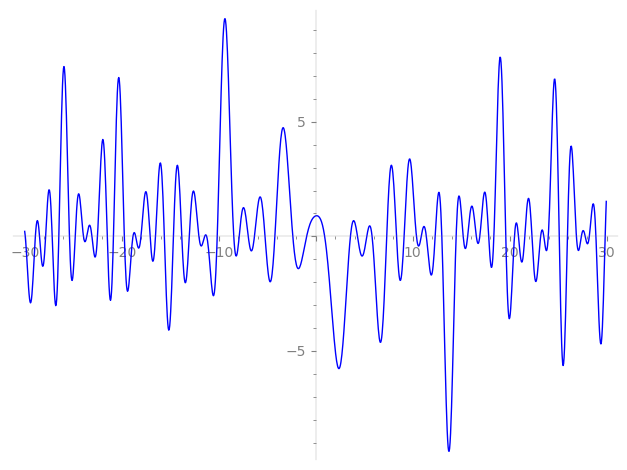| L(s) = 1 | + (−2.16 − 2.16i)3-s + (−1.91 + 1.14i)5-s + (2.61 + 0.409i)7-s + 6.36i·9-s − 0.796·11-s + (3.25 + 3.25i)13-s + (6.63 + 1.66i)15-s + (2.52 − 2.52i)17-s − 2.29·19-s + (−4.76 − 6.54i)21-s + (2.08 − 2.08i)23-s + (2.35 − 4.40i)25-s + (7.27 − 7.27i)27-s − 10.0i·29-s + 3.63i·31-s + ⋯ |
| L(s) = 1 | + (−1.24 − 1.24i)3-s + (−0.857 + 0.513i)5-s + (0.987 + 0.154i)7-s + 2.12i·9-s − 0.240·11-s + (0.901 + 0.901i)13-s + (1.71 + 0.429i)15-s + (0.611 − 0.611i)17-s − 0.527·19-s + (−1.04 − 1.42i)21-s + (0.434 − 0.434i)23-s + (0.471 − 0.881i)25-s + (1.39 − 1.39i)27-s − 1.87i·29-s + 0.652i·31-s + ⋯ |
\[\begin{aligned}\Lambda(s)=\mathstrut & 560 ^{s/2} \, \Gamma_{\C}(s) \, L(s)\cr =\mathstrut & (0.806 + 0.591i)\, \overline{\Lambda}(2-s) \end{aligned}\]
\[\begin{aligned}\Lambda(s)=\mathstrut & 560 ^{s/2} \, \Gamma_{\C}(s+1/2) \, L(s)\cr =\mathstrut & (0.806 + 0.591i)\, \overline{\Lambda}(1-s) \end{aligned}\]
Particular Values
| \(L(1)\) |
\(\approx\) |
\(0.851039 - 0.278784i\) |
| \(L(\frac12)\) |
\(\approx\) |
\(0.851039 - 0.278784i\) |
| \(L(\frac{3}{2})\) |
|
not available |
| \(L(1)\) |
|
not available |
\(L(s) = \displaystyle \prod_{p} F_p(p^{-s})^{-1} \)
| $p$ | $F_p(T)$ |
|---|
| bad | 2 | \( 1 \) |
| 5 | \( 1 + (1.91 - 1.14i)T \) |
| 7 | \( 1 + (-2.61 - 0.409i)T \) |
| good | 3 | \( 1 + (2.16 + 2.16i)T + 3iT^{2} \) |
| 11 | \( 1 + 0.796T + 11T^{2} \) |
| 13 | \( 1 + (-3.25 - 3.25i)T + 13iT^{2} \) |
| 17 | \( 1 + (-2.52 + 2.52i)T - 17iT^{2} \) |
| 19 | \( 1 + 2.29T + 19T^{2} \) |
| 23 | \( 1 + (-2.08 + 2.08i)T - 23iT^{2} \) |
| 29 | \( 1 + 10.0iT - 29T^{2} \) |
| 31 | \( 1 - 3.63iT - 31T^{2} \) |
| 37 | \( 1 + (-7.30 - 7.30i)T + 37iT^{2} \) |
| 41 | \( 1 - 2.81iT - 41T^{2} \) |
| 43 | \( 1 + (2.33 - 2.33i)T - 43iT^{2} \) |
| 47 | \( 1 + (-4.09 + 4.09i)T - 47iT^{2} \) |
| 53 | \( 1 + (-6.50 + 6.50i)T - 53iT^{2} \) |
| 59 | \( 1 - 11.4T + 59T^{2} \) |
| 61 | \( 1 + 3.35iT - 61T^{2} \) |
| 67 | \( 1 + (-2.49 - 2.49i)T + 67iT^{2} \) |
| 71 | \( 1 - 2.93T + 71T^{2} \) |
| 73 | \( 1 + (-4.93 - 4.93i)T + 73iT^{2} \) |
| 79 | \( 1 - 6.53iT - 79T^{2} \) |
| 83 | \( 1 + (1.14 + 1.14i)T + 83iT^{2} \) |
| 89 | \( 1 + 14.0T + 89T^{2} \) |
| 97 | \( 1 + (-4.30 + 4.30i)T - 97iT^{2} \) |
| show more | |
| show less | |
\(L(s) = \displaystyle\prod_p \ \prod_{j=1}^{2} (1 - \alpha_{j,p}\, p^{-s})^{-1}\)
Imaginary part of the first few zeros on the critical line
−11.24280684492910449948193792922, −10.15251745753113960024669733944, −8.446658797356751546355843633806, −7.88854190228292622811586196782, −6.95511173138799699373411680832, −6.31545861844560031766755762016, −5.22471056749842646486276253659, −4.20962567231724202057514247371, −2.36082289355813224557154147280, −0.936555323688326823546581776502,
0.921084003050239563386750148831, 3.57758217858715160907268070925, 4.30461978087392871347180198171, 5.26360653181150065772522132553, 5.80858121682162960778580870221, 7.31550944130617493850746048190, 8.326249100770760917220983987548, 9.109127952544391593475429049910, 10.38455741924820355888752809148, 10.87692319195026583870265319375

